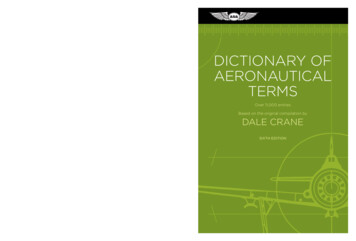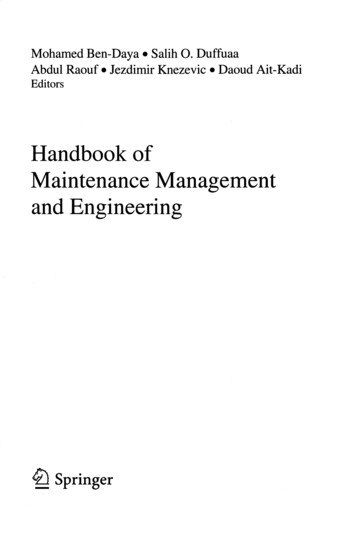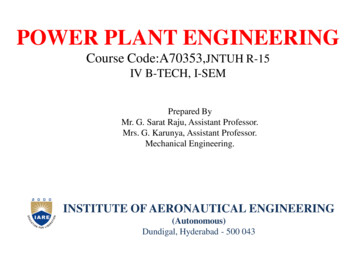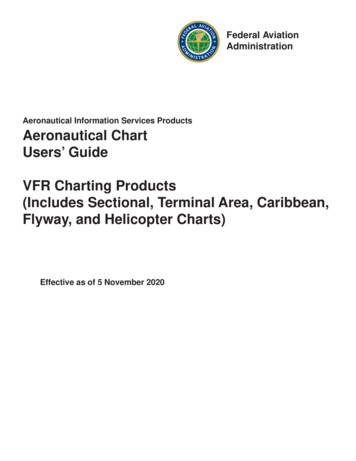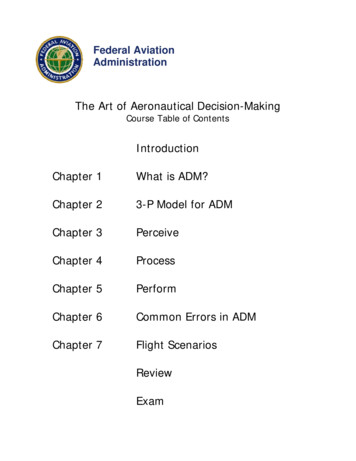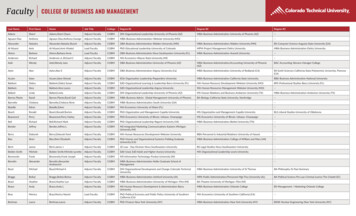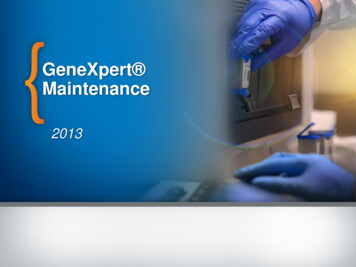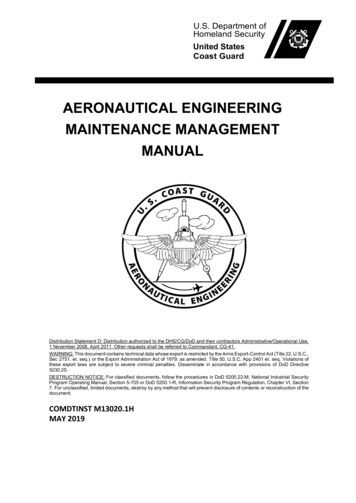
Transcription
U.S. Department ofHomeland SecurityUnited StatesCoast GuardAERONAUTICAL ENGINEERINGMAINTENANCE MANAGEMENTMANUALDistribution Statement D: Distribution authorized to the DHS/CG/DoD and their contractors Administrative/Operational Use,1 November 2008, April 2011. Other requests shall be referred to Commandant, CG-41.WARNING: This document contains technical data whose export is restricted by the Arms Export-Control Act (Title 22, U.S.C.,Sec 2751, et. seq.) or the Export Administration Act of 1979, as amended, Title 50, U.S.C. App 2401 et. seq. Violations ofthese export laws are subject to severe criminal penalties. Disseminate in accordance with provisions of DoD Directive5230.25.DESTRUCTION NOTICE: For classified documents, follow the procedures in DoD 5200.22-M, National Industrial SecurityProgram Operating Manual, Section 5-705 or DoD 5200.1-R, Information Security Program Regulation, Chapter VI, Section7. For unclassified, limited documents, destroy by any method that will prevent disclosure of contents or reconstruction of thedocument.COMDTINST M13020.1HMAY 2019
COMDTINST M13020.1HThis Page Intentionally Left Blank
CommandantUnited States Coast Guard2703 Martin Luther King Jr. Ave. SEWashington DC 20593-7714Staff Symbol: CG-41Phone: (202) 475-5570Fax: (202) 475-5958COMDTINST M13020.1H22 MAY 2019COMMANDANT INSTRUCTION M13020.1HSubj: AERONAUTICAL ENGINEERING MAINTENANCE MANAGEMENT MANUAL1. PURPOSE. This Manual establishes policies, procedures, and standards for theAeronautical Engineering Community.2. ACTION. All Coast Guard unit commanders, commanding officers, officers-in-charge,deputy/assistant commandants, and chiefs of headquarters staff elements shall ensurecompliance with the provisions of this Manual. Internet release is authorized.3. DIRECTIVES AFFECTED. The Aeronautical Engineering Maintenance ManagementManual, COMDTINST M13020.1G is cancelled.4. DISCLAIMER. This guidance is not a substitute for applicable legal requirements, nor isit itself a rule. It is intended to provide operational guidance for Coast Guard personnel andis not intended to nor does it impose legally binding requirements on any party outside theCoast Guard.5. MAJOR CHANGES. Major changes to the Manual include, but are not limited to:references to aircraft type, changes to the Airman program, and an addition to theRecommendations for Avionics Technical Libraries (Enclosure. (3)).6. ENVIRONMENTAL ASPECT AND IMPACT CONSIDERATIONS.a. The development of this Manual and the general policies contained within it have beenthoroughly reviewed by the originating office in conjunction with the Office ofEnvironmental Management, Commandant (CG-47). This Manual is categoricallyexcluded under current Department of Homeland Security (DHS) categoricalexclusion (CATEX) A3 from further environmental analysis in accordance with"Implementation of the National Environmental Policy Act (NEPA)", DHS InstructionManual 023-01-001-01 (series).ABCDEFGHDISTRIBUTION – SDL No. 170abcdefgXXXX XX X XXXX XX XXhijklXXmnopXXqrstuvXwxyXXXXNON-STANDARD DISTRIBUTION: COMDTs CG-41 (1), CG-531 (1), CG-1131 (1)XXz
COMDTINST M13020.1Hb. This Manual will not have any of the following: significant cumulative impacts on thehuman environment; substantial controversy or substantial change to existingenvironmental conditions; or inconsistencies with any Federal, State, or local laws oradministrative determinations relating to the environment. All future specific actionsresulting from the general policy in this Manual must be individually evaluated forcompliance with the National Environmental Policy Act (NEPA), Department ofHomeland Security (DHS) and Coast Guard NEPA policy, and compliance with allother applicable environmental mandates.7. DISTRIBUTION. No paper distribution will be made of this Manual. An electronicversion will be located on the following Commandant (CG-612) web sites: Internet:http://www.dcms.uscg.mil/directives/ and ives/SitePages/Home.aspx.8. RECORDS MANAGEMENT CONSIDERATIONS. This Manual has been evaluated forpotential records management impacts. The development of this Manual has beenthoroughly reviewed during the directives clearance process, and it has been determinedthere are no further records scheduling requirements, in accordance with Federal RecordsAct, 44 U.S.C. 3101 et seq., National Archives and Records Administration (NARA)requirements, and the Information and Life Cycle Management Manual, COMDTINSTM5212.12 (series). This policy does not have any significant or substantial change toexisting records management requirements.9. FORMS/REPORTS. The forms referenced in this Manual can be found on the Internet tion-Management-CG-61/Forms-Management/ or CGPortal ges/Home.aspx.10. REQUESTS FOR CHANGES. Units and individuals may recommend changes in writingvia the chain of command to Commandant (CG-41):Attn: Office of Aeronautical EngineeringU. S. Coast Guard, Stop 77142703 Martin Luther King Jr. AveSE Washington, D.C. 20593-7714N. A. MOORE /s/U.S. Coast GuardAssistant Commandant for Engineering & Logistics2
COMDTINST M13020.1HRECORD OF CHANGESCHANGENUMBERDATE OFCHANGEDATEENTEREDBYWHOM ENTERED
COMDTINST M13020.1HThis Page Intentionally Left Blank
COMDTINST M13020.1HTABLE OF CONTENTSCHAPTER 1MAINTENANCE MANAGEMENT POLICYA. General . 1-1B. Maintenance System Objective . 1-1C. Equipment Readiness. 1-1D. Maintenance System Organization . 1-1E. Maintenance Standardization . 1-2F.Management Actions on Inspection Reports . 1-2G. Maintenance Capability . 1-2H. Maintenance Effectiveness . 1-3I.Aircraft Availability . 1-3J.Maintenance Documentation . 1-4K. Financial Management . 1-4L.Cannibalization . 1-4M. Product Quality Deficiency Report (PQDR) . 1-5N. Modification and Changes to Aircraft . 1-5O. Aircraft Weight and Balance. 1-6P. Functional Checks of Aeronautical Equipment . 1-7Q. Aircraft Ownership .1-13R. Commandant’s Aeronautical Engineering Logistics Compliance Inspection(LCI). 1-13S. Reliability Centered Maintenance (RCM) Program . 1-13T.Flight Safety Critical Aircraft Parts (FSCAP) Program . 1-13U. Technical Airworthiness Assurance Program . 1-14V. Aviation Fuel Handling Program .1-15CHAPTER 2ORGANIZATIONA. General . 2-1B. Office of Aeronautical Engineering, Commandant (CG-41) . 2-1C. Program Manager, Commandant (CG-41d) . 2-2D. Aeronautical Engineering Systems Management Division, Commandant(CG-411). 2-3E. Aeronautical Engineering Resource Management Division, Commandant(CG-412). 2-4F.Aviation Logistics Center (ALC), Elizabeth City, NC . 2-6G. Typical Aviation Unit . 2-9H. Prime Unit .2-10CHAPTER 3 CLASSIFICATION OF AVIATION MAINTENANCE ACTIVITIESi
COMDTINST M13020.1HA. General .3-1B. Classifications .3-1C. Types of Classifications .3-2D. Unit Requirements .3-2CHAPTER 4DIRECTIVES AND PUBLICATIONSA. Overview.4-1B. Commandant Instructions .4-1C. Technical Orders .4-1D. Precedence of Directives .4-1E. Reference Publications .4-2F.Coast Guard Technical Order System .4-2G. Technical Manual Application System (TMAPS) .4-3H. Process Guides .4-3I.TCTOS .4-7J.Monitoring TCTOS .4-8CHAPTER 5AIRCRAFT INSPECTIONSA. General .5-1B. Definition of Inspections .5-1C. Requirements .5-3CHAPTER 6PERSONNEL AND TRAININGA. General .6-1B. Personnel Allowances .6-1C. Flight Orders .6-1D. Performance Qualifications .6-1E. Training.6-2CHAPTER 7SUPPORT EQUIPMENT (SE)A. General .7-1CHAPTER 8AVIONICSA. Scope .8-1B. General Avionics Publications.8-1C. General Avionics Maintenance .8-1D. Logistics.8-5E. Aircraft C4ISR Systems .8-8CHAPTER 9AVIATION LIFE SUPPORT EQUIPMENTA. Scope .9-1ii
COMDTINST M13020.1HB. General .9-1C. Equipment Types .9-1D. Organization .9-2CHAPTER 10 AIRCRAFT SALVAGEA. General .10-1B. Salvage Plans .10-1C. Assignment of Salvage Officers .10-1D. Responsibilities for Aircraft Recovery/Salvage. 10-1E. Coast Guard Vessel Recovery Capabilities .10-2F.Salvage References .10-3LIST OF TABLESTABLE 3-1. Maintenance Level Classification . 3-3TABLE 4-1. Aircraft Maintenance Technical Publication Resource . 4-3TABLE 5-1. Inspection Criteria for HC-130 Aircraft .5-5TABLE 5-2. Inspection Criteria for C-37 Aircraft and Other Command and Control. 5-6TABLE 5-3. Inspection Criteria for HC-27 Aircraft 5-6TABLE 5-4. Inspection Criteria for MH-65 Aircraft 5-8TABLE 5-5. Inspection Criteria for MH-60 Aircraft 5-9TABLE 5-6. Inspection Criteria for HC-144 Aircraft 5-10INDEXENCLOSURE INDEXEnclosure (1) MAINTENANCE LEVEL FUNCTIONSEnclosure (2) SAMPLE MAINTENANCE RELEASE AUTHORITY LETTEREnclosure (3) RECOMMENDATIONS FOR AVIONICS TECHNICALLIBRARIESEnclosure (4) REFERENCESiii
COMDTINST M13020.1HThis Page Intentionally Left Blank
COMDTINST M13020.1HCHAPTER 1 MAINTENANCE MANAGEMENT POLICY.A. GENERAL. This Manual provides a summary of the objectives, policies,organizational structures, and responsibilities which form the foundation for theUnited States Coast Guard (USCG) aeronautical maintenance managementsystem. This system is a composite of the United States Air Force (USAF) andNavy (USN) systems, commercial, and USCG developed procedures. Theprocedures required for uniform and effective management of aeronauticalmaintenance resources are contained in this Manual and referenced processguides.B.MAINTENANCE SYSTEM OBJECTIVE. The system objective is to ensure, inthe most cost-effective manner, that assigned materiel is serviceable (safe andoperable) and properly configured to meet mission requirements. This isaccomplished by performing maintenance, including but not limited to,inspection, repair, overhaul, modification, preservation, testing, and condition orperformance analysis. Emphasis is placed on planning and scheduling thesetasks by supervisors to allow timely accomplishment through the efficient use ofpersonnel, facilities, and equipment. Proper planning reduces unscheduledmaintenance events and allows for an orderly progression of maintenanceactions toward returning materiel to a safe and operable condition.C.EQUIPMENT READINESS. The key to a unit’s mission success is itssustained ability to provide safe, reliable, and properly configured equipment atthe time and place it is required. The degree of equipment readiness at anoperating unit should be put in context with the assigned mission. Failure torecognize the extent of equipment readiness required may result in excessiveacceptance of equipment deficiencies and a maintenance backlog. On the otherhand, unrealistically high readiness requirements may cause essentialmaintenance to be deferred with the same result. Either extreme serves toreduce a unit’s mission capability. Commanding Officers should ensureequipment is made available for maintenance when the resources are available.It is the Commanding Officer’s responsibility to ensure that maintenance iscompleted in an orderly and timely manner to meet the assigned missionrequirements.D.MAINTENANCE SYSTEM ORGANIZATION. Three basic elements comprisethe aeronautical maintenance system: a management element, a technicalelement, and a production element. Additional information concerning the dutiesand responsibilities of these elements is addressed in succeeding chapters ofthis Manual and associated process guides.1.Management Element. The Office of Aeronautical Engineering,Commandant (CG-41) at USCG Headquarters, has primary responsibilityfor the management element and serves as a focal point for technical andengineering support for systems and equipment in the operationalinventory.2.Technical Element. The Aviation Logistics Center (ALC) and field unitsdesignated “Prime Units” perform the major share of the technical elementof maintenance engineering under the direction of Commandant (CG-41).3.Production Element. Operating activities are concerned primarily withmaintenance production and provide the basic data inputs for maintenanceengineering decisions. Maintenance production is the physical performanceof equipment maintenance and related functions such as servicing, repairing,testing, overhaul, modification, calibration, conversion, and inspection. Thesetasks are performed at two levels: organizational and depot.1-1
COMDTINST M13020.1Ha.Organizational-Level Maintenance.USCG organizational-levelmaintenance includes both the Department of Defense (DoD) levelsdescribed as organizational and intermediate. Individual units have theresponsibility to perform unit level maintenance on their assignedequipment. This normally consists of inspecting, servicing, lubricating,adjusting, and replacing components, minor assemblies, andsubassemblies. It also consists of calibrating, repairing, or replacingdamaged or unserviceable parts, components, and assemblies;modifying materiel, emergency manufacturing of unavailable parts; anddeveloping/providing internal technical assistance.b.Depot-Level Maintenance.Designated maintenance activities performdepot-level maintenance to augment stocks of serviceable materiel andsupport unit level maintenance activities. These depots have moreextensive shop facilities and equipment and personnel of highertechnical skill than are normally available at the lower levels ofmaintenance. Depot-level maintenance is normally accomplished by ALCand other overhaul activities designated by Commandant (CG-41).E.MAINTENANCE STANDARDIZATION. Standardized maintenance improvesoverall maintenance quality, capability, and reliability. The required level ofstandardization will be achieved through application of the maintenancemanagement procedures prescribed by this Manual and associated processguides.F.MANAGEMENT ACTIONS ON INSPECTION REPORTS. Inspection reports,whether from unit quality control or other inspections, are valuable managementtools that must be given special attention. Positive action is required to identifyand eliminate the causes of the specific defects noted. Supervisors shouldensure that responsible individuals are made aware of deficiencies and becomeinvolved in correcting the problems. Review of corrective actions is incumbent onthe Commanding Officer and Engineering Officer to ensure underlying causes fordiscrepancies are identified and rectified to preclude their recurrence.G.MAINTENANCE CAPABILITY. Maintenance capability is the ability of a unit tomaintain assigned equipment in serviceable condition and proper configuration.Development of this capability begins with systems requirements definition foracquisition. Systems requirements analysis is performed to determine the systemcapabilities, adequacy of the requirements definition, and whether the systemsmeet these requirements. While defining requirements and determiningcapabilities, the system requirements analysis also develops the overall systemmaintenance philosophy. The overall maintenance philosophy determines boththe depot and organizational-level maintenance capabilities. This determinationis based on the requirement for organizational-level maintenance to support themission and the cost effectiveness of in-house depot-level capability. The unitcapability is then translated into resources of unit facilities, billets, and the unitspares allowance list, which drives procurement and positioning of spare parts.Engineering Officers must gauge their maintenance capability when planning tomeet mission requirements. If maintenance capability is exceeded for extendedperiods, maintenance quality will suffer, and ultimately, mission requirements willnot be met and safety will be compromised. See Enclosure (1).1. Maintenance Work Hours. Because the number of maintenance workhours available is limited, the Engineering Officer must take considerablecare with this resource. Every effort should be made in maintenance plansand schedules to ensure personnel are productively employed throughouttheir workshift.2. Sparing Levels. Sparing levels of critical components and piece-parts are1-2
COMDTINST M13020.1H3.based on a predicted mean time between failures. Service-wide budgetaryrestrictions also impact levels of sparing through reduced funds for partsbuys and contracted rework. To prevent shortages elsewhere in the fleet,Engineering Officers should ensure only the authorized level of sparing ismaintained; making use of supply practices such as parts pooling as muchas possible to maintain readiness levels without stocking excessiveinventory.Maintenance Capability and Mission Accomplishment. The relationshipbetween maintenance capability and successful accomplishment of themission must be clearly understood. When resource deficiencies exist, theEngineering Officer should request and justify additional resources tosupport a continuous workload or request temporary assistance to performemergency workloads. Assistance may be requested to performmaintenance beyond the unit’s capability. The Personnel Resources andReprogramming Manual, COMDTINST M5312.13 (series), providesguidance, policy, and procedures on the subject of Personnel Resources.Where resources (parts or personnel) are not available or cannot be madeavailable, reductions in mission requirements may be necessary.H.MAINTENANCE EFFECTIVENESS. The Aeronautical Engineering systemprovides integrated logistical support for all aspects of Coast Guard Aviation.When fully effective, the Aeronautical Engineering system produces aircraft thatsatisfy operational requirements in a reliable, maintainable, and supportablefashion.A system of measurements of effectiveness (MOEs) indicates the performanceof Coast Guard Aeronautical Engineering as related to strategic plans and goals.This MOE system consists of multi-dimensional indices and individual data points.These are taken collectively and considered over time to adequately reflectoverall system performance. These measures are available through the AssetLogistics Management Information System (ALMIS) Decision Support System(DSS). Engineering Officers at Air Stations must also monitor and measure theeffectiveness of their maintenance efforts.I.AIRCRAFT AVAILABILITY. Availability of aircraft to perform operationalmissions is dependent on a wide range of variables. An Availability Index (AI)indicates the percentage of time that aircraft assigned to Air Stations areavailable to perform Coast Guard missions. It is defined as follows:AI [100-NMCT] whereNMCT Not Mission Capable Total NMCM NMCS NMCD (units).NMCM is Not Mission Capable due to Organizational-level Maintenance.NMCS is Not Mission Capable due to Supply.NMCD (units) reflects the portion of Not Mission Capable Time due to DepotLevel Maintenance which is performed at a unit.A more detailed definition of NMC categories can be found in CGTO PG-85-00110, Chapter 3.1.NMCT Target. The USCG target for aircraft availability is 71% (whichequates to an NMCT of 29%). This is the goal for mature aircraft systems butis only one of many indicators of maintenance effectiveness.2.NMCS Target. A target of 5% is a planning goal for NMCS rates (thisequates to a parts availability rate of 95%). This target also serves as a1-3
COMDTINST M13020.1Hjustification for resources required to meet an NMCT rate of 29%. However,the Coast Guard must strive to meet these targets at minimum total systemcosts. The greatest efficiencies can be realized through minimizing inventoryinvestment at ALC and in unit allowances consistent with this goal.J.MAINTENANCE DOCUMENTATION. Documentation is an essential part ofmaintenance management. The objective of maintenance documentation is toprovide the Engineering Officer with timely, complete, and accurate maintenanceproduction data for planning, control, and analysis, and to provide an accuraterecord of completed work. It also provides performance data to managers at alllevels and is essential in the development of a maintenance managementinformation system. Additionally, this information will aid in identifying problemparts or items and in the development of yearly budgets.K.FINANCIAL MANAGEMENT. Management of funds plays a key role inmaintenance. The Engineering Officer is responsible for financial planning,preparation of budget requirements, and controlling expenditures within budgetallocations. Exact procedures will vary among operating units; however, theprimary goal of financial management at the unit level is to receive the maximumbenefit from the funds available.L.1.Responsibilities. The Financial Resource Management Manual (FRMM),COMDTINST M7100.3 (series), provides detailed information concerningthe responsibilities of the various levels of the USCG organization regardingadministration of appropriated funds. All personnel involved in the planningfor, or expenditure of, appropriated funds should have a working knowledgeof the system described therein.2.Allocation of Funds. Operating aviation units receive funds under AFC-30.Each district and operating activity has developed procedures for theallocation of these funds within their areas of responsibility. CommandingOfficers have final authority regarding the sub-allocation of funds to variousdepartments. The Engineering Officer should ensure that planning for andexpenditure of assigned funds is consistent with the overall objective of theunit maintenance plan.CANNIBALIZATION. Cannibalization is the removal of a specific assembly,subassembly, or component from one equipment end item for installation onanother to meet mission requirements. Cannibalization is a costly practice interms of time, labor-hours, documentation, and damaged equipment.Cannibalization shall be closely controlled and monitored. All cannibalizationactions shall be authorized by the Engineering Officer or his/her designatedrepresentative.NOTEAll cannibalizations will be recorded in theElectronic Asset Logbook (EAL) as amaintenance record entry. CannibalizationRemoval (CR) entries are recorded against thedonating aircraft and Cannibalization Installation(CI) entries are recorded against the receivingaircraft IAW CGTO PG-85-00-110.M.PRODUCT QUALITY DEFICIENCY REPORT (PQDR). PQDRs are a necessarysupplemental process used to document and facilitate maintenance proceduresfor all aircraft parts; components, and systems that do not meet “mean timebetween failure” or form, fit, and function for the design and engineering of thatpart, component or system. The PQDR Process is an automated system used toidentify, document and control those parts, components, and systems that fail to1-4
COMDTINST M13020.1Hmeet the OEM specifications and allow for an independent review of the specificincident regarding the part in question. See the Aeronautical EngineeringMaintenance Management Process Guide, CGTO PG-85-00-110 for furtherguidance on PQDRs.N.MODIFICATION AND CHANGES TO AIRCRAFT.1.General. The Commandant encourages improvement of USCG aircraftwhile preserving standardization and providing guidance to accomplishaircraft modification or change projects. These instructions are intended tosupplement any general instructions governing aircraft testing. The termaircraft, as used in this sense, includes related systems and supportequipment. Refer to Chapter 8 for more specific guidance on avionicscomponents.2.Changes or Modifications. All changes or modifications to aircraft must bereviewed by the appropriate technical authority at ALC and approved via theACCB process. Any changes or modifications that could adversely affectstructural loads, aerodynamic characteristics, weight and balance, orperformance will be thoroughly documented, and mitigation of these affectswill be detailed in the ACCB submission. Temporary modificationauthorization will include the effective dates for installation and removal.3.Procedures.a.Operational Requirements. Recommendations for changes ormodifications to fulfill operational requirements or improve missionperformance shall be addressed to the Platform Manager,Commandant (CG-711), copy to the system ma
Aug 23, 2019 · maintenance production and provide the basic data inputs for maintenance engineering decisions. Maintenance production is the physical performance of equipment maintenance and related functions such as servicing, repairing, testing, overhaul , mod
